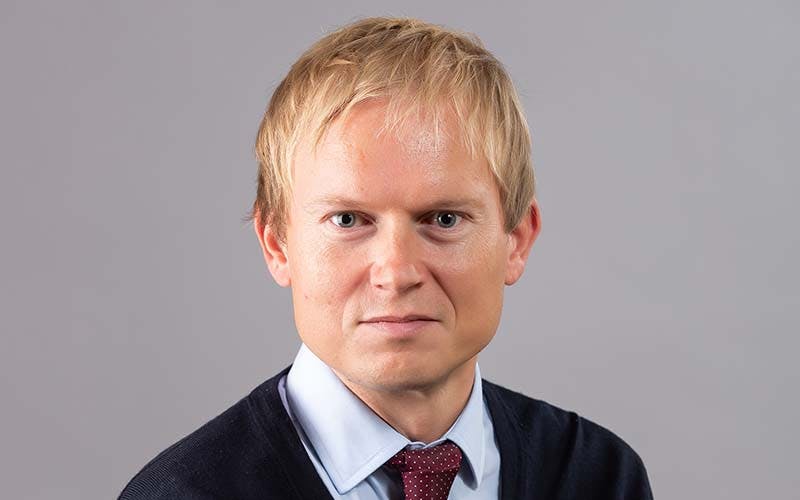Flash note

“We need to speed up the energy transition”
- Publicado
-
Duração
5 minutos de leitura

Now that COP26 has come to a close, urgent action is required to speed up the energy transition so that we can achieve the goal of carbon neutrality by 2050, says Michel Wiskirski, Fund Manager of Carmignac Portfolio Climate Transition.
Now that the United Nations Climate Change Conference (COP26) has come to a close, where are we with regard to the goal of carbon neutrality by 2050?
Michel Wiskirski: Although the outlook isn’t entirely bleak, according to the International Energy Agency (IEA), the commitments made over the last 10 years amount to less than 20% of what’s needed to achieve the European Union’s goal of carbon neutrality by 2050. So, we need to speed up the energy transition.
What’s causing the delay?
M.W.: The world isn’t investing enough to meet its future energy needs. Although spending on the transition is gradually increasing, the momentum is insufficient, and the resources allocated aren’t nearly enough to meet the demand for energy services in a sustainable manner.
So, it’s mainly down to insufficient investment?
M.W.: Funding is clearly the missing link. Big political announcements are made but when it comes to implementing them, good intentions aren’t followed up by actions. The difficulties involved in cutting red tape shouldn’t be underestimated, particularly in Germany and the US.
You mentioned a lack of funding. In concrete terms, where do we stand?
M.W.: The Paris Agreement adopted six years ago aims to limit global warming to 1.5 degrees Celsius above pre-industrial levels. To achieve this goal – reaffirmed at COP26 – annual investments in clean energy projects and infrastructure should amount to nearly USD 4 trillion by 2030, according to the IEA. The investments made to date represent only a few hundred million dollars per year.
Does this lack of investment in green energy explain the rise in oil and gas prices that we’ve been seeing for over a year?
M.W.: There are several factors behind these price increases. The lack of investment in green energy isn’t the only cause. However, the lack of development and start-up of new renewable energy production structures is clearly part of the problem, since energy needs have now returned to levels close to those seen before COVID-19. At the same time, current fossil fuel and renewable energy production capacities aren’t enough to meet this demand. If we want to make the energy transition a success, we can’t cut back on fossil fuels without at the same time strongly increasing investment in renewable energies. To date, too few alternative energy projects have been launched. With this in mind, and in order to avoid creating a new problem while solving another, the energy transition must be inclusive.
What do you mean?
M.W.: Energy production is a very complex global chain with many players involved. To meet the challenges of the energy transition, it isn’t enough to ban gas boilers or diesel cars, or to stop opening new coal mines. We have to involve oil and gas companies, so that they produce enough energy to meet demand while at the same time reducing CO2 emissions. It’s a major issue because in a transitional scenario these companies are also part of the answer, particularly in the current context of underinvestment. The effort made all along the production chain – from fossil fuel extraction to clean alternatives at the pump – is what counts and it should be monitored and encouraged.
So, the end of fossil fuels isn’t just around the corner?
M.W.: No, because the world economy still needs them. In the case of oil, demand will continue for many years to come, at least until an alternative is found. Demand for oil is even expected to grow up to 2030, at which point it should start to decline. Thereafter, we expect it to fall sharply – by 2050 it may have fallen by as much as 75% from 2020 levels – with less use in the production of plastics or electric vehicles, for example.
What about gas?
M.W.: It’s important to stress the crucial role that gas should play in the energy transition. If we want more renewable energy, we also need stable sources of energy, such as natural gas or nuclear, during the transition period. So, we have to invest in expanding our natural gas production capacity, especially since gas is listed in the EU Taxonomy1 as a key element of the energy transition and among the green energy sources of tomorrow’s energy mix. In addition to the economic considerations of oil and gas production, there’s also a social dimension that shouldn’t be ignored.
What do you mean?
M.W.: It’s often overlooked, but around 40 million people worldwide work directly for the oil and gas industry, while many regions within developing countries depend solely on this sector, or flourish, thanks to it. For all these reasons, we have to reflect on the best way to support this sector in the years to come in order to help the world economy meet the challenges posed by the energy transition.
What about new technologies, whose energy consumption is sometimes criticised? Might they be useful?
M.W.: While there are obviously exceptions, such as cryptocurrencies, for example, which are very energy intensive, new technologies are essential to the energy transition. They’re absolutely crucial to achieving the goal of carbon neutrality. It’s thanks to new technologies that we’ll overcome the challenges of storing renewable energies, using hydrogen as an energy source, or capturing CO2 from the atmosphere and storing it underground.
Whether it’s a question of new technologies or transitional solutions, policymakers have a key role to play here.
M.W.: Absolutely. Their commitment to progress is essential, and the political agenda for the second half of the year is packed with environmental issues. In July, the European Union detailed a roadmap for reducing its greenhouse gas emissions in 2030 by 55% compared with 1990. On the other side of the Atlantic, the Biden administration has made climate a top priority since the beginning of his term, with significant measures expected in the upcoming infrastructure plan or in some other form. However, the culmination of the climate agenda was clear at COP26’. It remains to be seen how all these announcements will turn out in practice.
How are you personally managing the energy transition?
M.W.: First of all, Carmignac has a global approach based on our ability to invest, to commit and to influence corporate governance decisions at all levels. Secondly, we have a specialised fund, Carmignac Portfolio Climate Transition, which invests in three themes that will enable us to meet the challenges of the energy transition and achieve carbon neutrality by 2050: 1) clean energy producers, i.e. companies offering renewable energy production solutions; 2) “enablers”, i.e. companies that help us decarbonise all segments of our economy, including those that are not immediately or intuitively recognisable; 3) key players in the transition, i.e. companies considered environmentally problematic that we help to meet the challenges of sustainable development since we believe they can provide solutions if given support.
1The EU Taxonomy is an EU regulation that aims to classify economic activities in order to identify those that can be considered “environmentally sustainable” or “green” (source: Banque de France)
Carmignac Portfolio Climate Transition A EUR Acc
Horizonte de investimento mínimo recomendado
Risco mais baixo Risco mais elevado
. .
AÇÕES: O Fundo pode ser afetado por variações nos preços das ações, numa escala que depende de fatores externos, volumes de negociação de ações ou capitalização bolsista.
CAMBIAL: O risco cambial está associado à exposição a uma moeda que não seja a moeda de avaliação do Fundo, através de investimento direto ou do recurso a instrumentos financeiros a prazo.
COMMODITIES: As variações nos preços das commodities e a volatilidade do setor poderão provocar a descida do valor patrimonial líquido.
GESTÃO DISCRICIONÁRIA: Previsões de alterações nos mercados financeiros feitas pela Sociedade Gestora surtem um efeito direto sobre o desempenho do Fundo, o qual depende das ações selecionadas.
Este fundo não possui capital garantido.